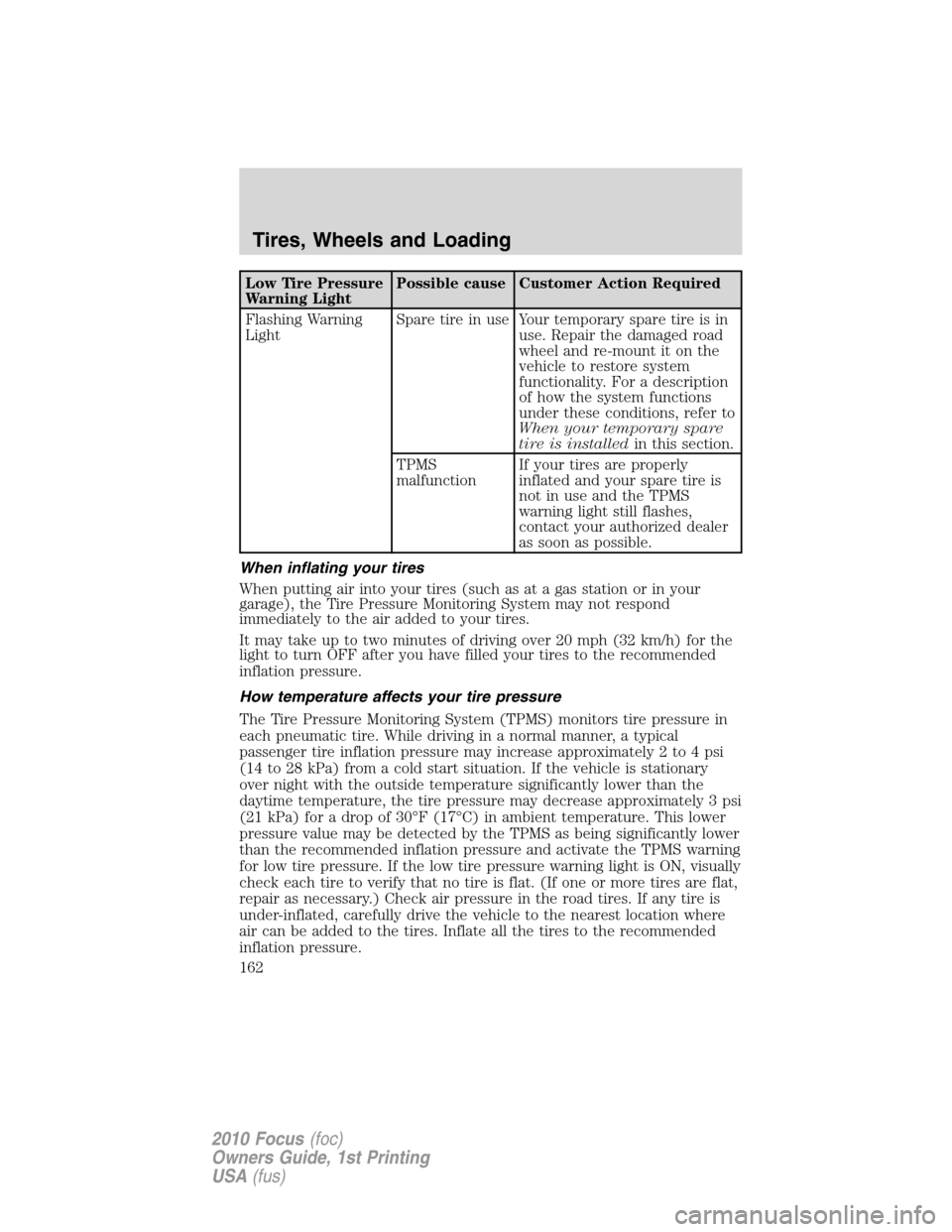Page 162 of 275

Low Tire Pressure
Warning LightPossible cause Customer Action Required
Flashing Warning
LightSpare tire in use Your temporary spare tire is in
use. Repair the damaged road
wheel and re-mount it on the
vehicle to restore system
functionality. For a description
of how the system functions
under these conditions, refer to
When your temporary spare
tire is installedin this section.
TPMS
malfunctionIf your tires are properly
inflated and your spare tire is
not in use and the TPMS
warning light still flashes,
contact your authorized dealer
as soon as possible.
When inflating your tires
When putting air into your tires (such as at a gas station or in your
garage), the Tire Pressure Monitoring System may not respond
immediately to the air added to your tires.
It may take up to two minutes of driving over 20 mph (32 km/h) for the
light to turn OFF after you have filled your tires to the recommended
inflation pressure.
How temperature affects your tire pressure
The Tire Pressure Monitoring System (TPMS) monitors tire pressure in
each pneumatic tire. While driving in a normal manner, a typical
passenger tire inflation pressure may increase approximately 2 to 4 psi
(14 to 28 kPa) from a cold start situation. If the vehicle is stationary
over night with the outside temperature significantly lower than the
daytime temperature, the tire pressure may decrease approximately 3 psi
(21 kPa) for a drop of 30°F (17°C) in ambient temperature. This lower
pressure value may be detected by the TPMS as being significantly lower
than the recommended inflation pressure and activate the TPMS warning
for low tire pressure. If the low tire pressure warning light is ON, visually
check each tire to verify that no tire is flat. (If one or more tires are flat,
repair as necessary.) Check air pressure in the road tires. If any tire is
under-inflated, carefully drive the vehicle to the nearest location where
air can be added to the tires. Inflate all the tires to the recommended
inflation pressure.
Tires, Wheels and Loading
162
2010 Focus(foc)
Owners Guide, 1st Printing
USA(fus)
Page 199 of 275

CHANGING A FLAT TIRE
If you get a flat tire while driving:
•do not brake heavily.
•gradually decrease the vehicle’s speed.
•hold the steering wheel firmly.
•slowly move to a safe place on the side of the road.
Your vehicle may be equipped with a conventional spare tire that is
different in one or more of the following: type, brand, size, speed rating
and tread design. If this is the case, this dissimilar spare tire is still rated
for your vehicle loads (GAWR and GVWR). This temporary spare tire is
not equipped with a tire pressure monitoring system (TPMS) sensor.
Note:The tire pressure monitoring system (TPMS) indicator light will
illuminate when the spare is in use. To restore the full functionality of
the TPMS system, all road wheels equipped with the tire pressure
monitoring sensors must be mounted on the vehicle.
Have a flat tire serviced by an authorized dealer in order to prevent
damage to the TPMS sensor, refer toTire Pressure Monitoring System
(TPMS)in theTires, Wheels, and Loadingchapter. Replace the spare
tire with a road tire as soon as possible. During repairing or replacing of
the flat tire, have the authorized dealer inspect the TPMS sensor for
damage.
WARNING:The use of tire sealants may damage your Tire
Pressure Monitoring System and should not be used.
WARNING:Refer toTire Pressure Monitoring System (TPMS)
in theTire, Wheels and Loadingchapter for important
information. If the tire pressure monitor sensor becomes damaged, it
will no longer function.
Dissimilar spare tire/wheel information
WARNING:Failure to follow these guidelines could result in an
increased risk of loss of vehicle control, injury or death.
Roadside Emergencies
199
2010 Focus(foc)
Owners Guide, 1st Printing
USA(fus)
Page 274 of 275

Recommendations for
attaching safety restraints for
children ......................................127
Relays ........................................192
Remote entry system .................74
illuminated entry ................77–78
locking/unlocking doors .....74–75
opening the trunk .....................75
panic alarm ...............................75
replacement/additional
transmitters ...............................76
replacing the batteries .............76
Roadside assistance ..................190
S
Safety belts
(see Safety restraints)...96, 99–104
Safety Canopy ...........................119
Safety defects, reporting ..........219
Safety restraints ............96, 99–104
Belt-Minder�...........................105
extension assembly ................105
for adults .........................100–103
for children .............................125
Occupant Classification
Sensor ........................................97
warning light and chime ........105
Safety restraints - LATCH
anchors ......................................135
Safety seats for children ..........129
Safety Compliance
Certification Label ....................262
Satellite Radio (if equipped) .....25
Satellite Radio Information ........38
Seats ............................................88
child safety seats ....................129
heated ........................................93SecuriLock passive anti-theft
system ..........................................78
Servicing your vehicle ..............227
Setting the clock .........................25
Side air curtain .........................121
SOS Post Crash Alert ...............124
Spark plugs,
specifications .............257, 261–262
Specification chart,
lubricants ...................................258
Speed control ..............................61
Starting your vehicle .......171–172,
174
jump starting ..........................205
Steering wheel
controls ......................................64
tilting .........................................56
Stereo
CD-MP3 .....................................25
SYNC�..........................................41
T
Tilt steering wheel ......................56
Tire Pressure Monitoring
System (TPMS)
Tires, Wheels and Loading ....158
Tires ...................................144–145
alignment ................................152
care ..........................................148
changing ..................................202
checking the pressure ............148
inflating ...................................146
label .........................................158
replacing ..................................150
rotating ....................................152
safety practices .......................151
sidewall information ...............153
Index
274
2010 Focus(foc)
Owners Guide, 1st Printing
USA(fus)